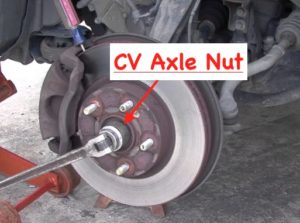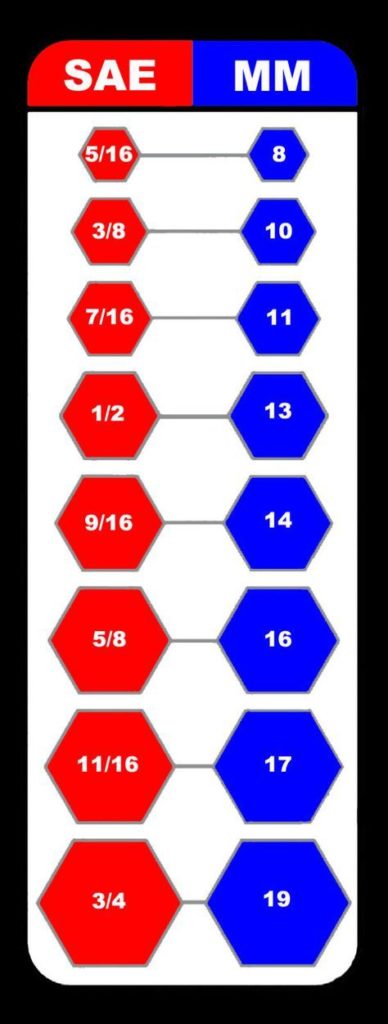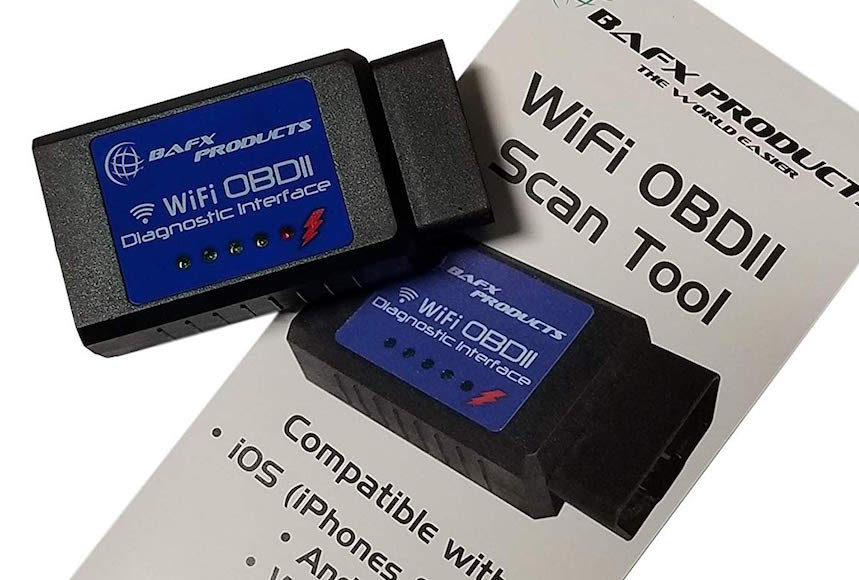Table of Contents
Metric versus SAE (Standard) Sockets:
The difference between Metric and SAE sockets is similar to the difference between yards and meters. Metric fasteners are (generally) used on imported cars, and SAE fasteners are (generally) used on domestic (USA) made cars. Also, they are two completely different systems of measurement. Metric sockets use the metric measurement system i.e., millimeters to describe their size (e.g., an 18mm socket). SAE, or standard size, use the imperial measurement system we invented in the USA. Therefore, sockets are described in fractions of an inch, i.e., 1/2″ socket. Make no mistake however, in 2020, you will find metric and SAE fasteners on domestic cars. Unless you are working on solely older American cars, you will find yourself using your Metric sockets 9/10 times.
Sometimes a metric fastener is close enough in size that an SAE socket may work and vice versa for metric sockets on SAE fasteners. While there are some very close crossover sockets between Metric and SAE, I would advise you to avoid substituting sockets or tools in general between the tool systems.
You want to try to avoid using metric sockets on SAE fasteners, and SAE sockets on metric fasteners. The simple reason is that while it may feel like it fits okay, many times you risk a higher chance of stripping the bolt or fastener using the wrong socket.
Pro tip: Be careful, and use my guide listed below to see what fasteners are usually close enough metric and SAE to use the same sockets/wrenches.
SAE and Metric Have Historical Beef:

If you’re going to be working on both types of cars, foreign and domestic, you will need both SAE sockets and metric sockets. However, the general trend is moving away from SAE fasteners and more companies are going 100% metric. This also includes Ford, Dodge, and most “Domestic” car brands that are actually made with mostly oversea’s parts or built in Mexico. They are moving towards using mostly metric sizes as well.
Why do no metric drive sizes exist:
Both metric and SAE sockets are available in three drive sizes: ¼”, 3/8″ and ½”. Interestingly enough because the original ratchet was an American invention, metric sockets still use imperial sized drivers. The drive dimensions always followed the US sizes, 1/4″, 3/8″, 1/2″, 3/4″ drives to be exact. This really is great for you, because it means one less thing to have buy another set for. It would be a real pain if metric sockets also had their own special ratchets with metrically sized drivers. We can thank our lucky stars this isn’t the case.
Smaller sockets typically use smaller drive sizes, while larger sockets use the larger drive sizes. For example, a 6mm socket (relatively small for automotive repair) will most commonly be sold in the 1/4″ drive size.
Common sizes for metric sockets:
The most common sizes for metric sockets for automotive repair are 8mm to 19mm sockets. You will most commonly find socket sets that are sold that contain all the sockets between 8mm to 19mm. Most metric socket sets, wrenches, and flare nut wrenches will contain these metric sizes (6mm, 7mm, 8mm, 9mm, 10mm, 11mm, 12mm, 13mm, 14mm, 15mm, 16mm, 17mm, 18mm, 19mm.) The absolute most commonly used socket for any car repair is the 10mm socket. Followed closely by 12mm, 14mm, 17mm, and 19mm sockets. You should have a high-quality set of metric sockets for all the different drives, or at least adapters, and separate lug nut sockets.
There are also some common metric sized bolts that require larger metric socket sizes as well. On many imported cars, you will find the lug nuts will commonly be 19mm or 21mm. However, on some cars or trucks, the lug nuts will require even larger metric sockets, and you should be prepared and have those sizes.
Common sizes for SAE / Imperial / Standard sockets:
The most commonly used and sold SAE sizes for wrenches and sockets are:
- Standard socket sizes 5/16″, 3/8″, 7/16″, 1/2″, 9/16″, 5/8″, 11/16″, 3/4″, 13/16″, 7/8″, 1″, 1-1/4″, 1-7/16″, 1-1/2″ etc. Any larger than around 7/8″ is usually on an as needed basis. Unless you are working on heavy-duty trucks or cars, then you should get a set that goes all the way up the 1-1/4″ or larger.
Depending on what kind of cars, motorcycles, scooters you are working on there are some SAE sockets that may come in handy. Although, as many technicians will tell you the number is dropping fast. You can usually get by without many SAE wrenches and sockets, but when you do need them you’ll be happy you have a set.
I would say unless you’re working on domestic cars only, start with metric sets first. Maybe grab one SAE socket set, then fill in wrenches, etc as you find you need. Otherwise, don’t spend your money on SAE tools until you see whether you need them or not. Metric are becoming much more common on all things cars, motorcycles, and even domestic trucks.
Common metric lug nut sizes and the kinds of cars that use them:

21mm Most of Toyota’s (Common)
19mm Volvo, Subaru’s, Some Honda’s, Some Domestic Cars (Very common size)
22mm Chevy Fullsize New Honda’s Ford van’s
22m for many Ferrari’s
23mm Dodge Fullsize Trucks
27mm *weird one* for Land Rover’s
Lugnut sockets need to have a protective soft coating. That way you don’t ruin your rims by scratching them with the sides of the socket.
A lot of companies these days are making really cool reversible lug nut socket sets (so there are two different lug nut sockets built into the same socket).
When you are searching to buy a lug nut socket set make sure it has the sizes you’ll need for the majority of cars you will be working on. I recommend buying the Chicago Pneumatic Lug Nut Socket Set that includes 11 sockets that meet all the most common SAE and metric lug nut sizes.
The kit comes with these 1/2″ drive sockets 3/4, 13/16, 7/8, 15/16, 1, 1-1/16 in., 17mm, 19mm, 21mm, 22mm and 23mm. If you do have a weird Land Rover you will need to get a separate 27mm socket for those lug nuts.
You will also need large metric sockets for Axle Nuts:

For the purposes of this discussion, I will be using hub nut/spindle nut/axle nut/axle drive nut/ to mean the same thing. The nut that holds the CV axle to the hub.
Common axle nut/spindle nut sizes / here is what I found:
Honda mostly uses 32mm axle and spindle nut sizes.
Small Chevys and Toyotas use 30 mm.
Mitsubishi likes to use 32 mm.
Volkswagens are mostly 30 mm 12 point nuts. (1993+ VW’s went up to 12point spindle nut size) You will need a 12 point 30mm socket to remove.
C5 and C6 Corvettes use a 34 mm spindle nut.
Mid 90’s BMW’s need a 46mm socket to remove the hub nut.
Honda JDM Type R’s require a 36mm Socket
30mm 32mm or 36mm on Nissan’s depending on year make and model.
General Motors (GM) 1/2 ton trucks front cv axle is a 34mm or 36mm
Kia’s Spindle Nut size: 35-36mm
Mazda 30mm, 32mm, 35mm (a bit of a weird one) on some
Toyota Tundra’s, Landcruiser, and Highlander 39mm socket (also an uncommon size) front axle nut size
Astro Vans: 27mm (weird one) front axle nut size.
To check out a really cool chart that includes most vehicles and the spindle nut sizes click here.
To find out what spindle nut size your car or truck has just google it. Here’s how to do phrase it:
“Your (Make, model and year) CV axle nut size). Then order the right socket for your vehicle.
Axle Nut Socket Set Buying Guide:
If you’re looking for a good axle nut socket set to buy I did some research and found that these sets are the best value.
- OEM TOOLS 24480 12 Point Axle Nut Socket Set (8 Piece)
- 1/2″ Drive / Impact Rated / Well Reviewed
- 29, 30, 32, 34, 35, 36, 38 and 39 mm sizes (Look above that covers 90% what you need)
- Comes with a sturdy plastic case making transport easier.
- Click here to read current reviews and get the price.
- Astro Pneumatic Tool 12-Point Axle Nut Socket Set (8 Piece) *Slightly More Expensive*
- Designed for an exact fit on both 6pt and 12pt axle nuts (I am pretty sure the OEM TOOLS one will work for both as well). But this is comforting to know they advertise as working for both 6 point and 12 point CV axle spindle nuts.
- 1/2″ drive Impact Drive
- Includes large 39mm socket for Toyota/Lexus applications
- 29mm, 30mm, 32mm, 34mm, 35mm, 36mm, 38mm, 39mm (Exact same as the OEM tools set).
- If you’re working on mostly Volkswagen and Audi Specific buy this Axle Nut Socket Set:
- Assenmacher 6506 6 Piece VW/Audi Axle Nut Socket Set
- Covers all Volkswagen/Audi axle nuts from [1996-2013].
- Includes a 14mm and 17mm Allen as well as an 18mm 24mm 30mm and 32mm 12-point sockets
- Assenmacher 6506 6 Piece VW/Audi Axle Nut Socket Set
Can you use Metric sockets on SAE fasteners or SAE Sockets on Metric Fasteners?
Yes, you can use some sockets on both metric and SAE sizes. However, you need to be careful, as most times they are not exactly the same, and you can strip a bolt by using an SAE socket on a metric bolt and vice versa.

Here is a general rule of thumb for metric / SAE sockets that are the same (or close enough):
- 5/16″=8mm
- 7/16″=11mm
- 1/2″=13mm
- 9/16″=14mm
- 5/8″=16mm
- 11/16″=17mm
- 3/4″=19mm
- 7/8″=22mm
- 15/16″=24mm
- 1-1/16″=27mm
- 1.5″=38mm.
Remember those are general guidelines, however, you may find the socket or wrench does not fit your bolt. Go out and buy the SAE or metric sized socket you need, before you strip anything important.
As a rule; “if it doesn’t fit, just quit!”
Should I buy metric sockets or SAE sockets?
If you plan on working on any imported cars (Honda, Toyota, Kia, Hyundai, Subaru, Mitsubishi, Nissan etc etc.,) you will need metric sockets. 9/10 on imported cars you will only need metric sockets, and will never need to use SAE tools.
That being said if you’re working only domestic cars, you will likely need both SAE and metric sockets. From my experience, all Japanese, Korean and German brands are metric. Some U.S. brands are all SAE or are all metric, even worse, some US brands used half metric and half SAE during certain years.
I know it sucks. I wish the companies would agree and all use the same system of fasteners. Some cars and trucks even used some metric fasteners and some SAE fasteners on the same car. The engine may have been imported from overseas (therefore metric) and the body may have been assembled in the USA (SAE bolts). Those can be a real pain the butt.
If you’re anything like me you are mostly working on imported cars. I am partial to imported cars, and generally just prefer them to work on. So 90% of my tools are metric tools.
I highly recommend filling out your socket sets with metric first, then fill in any SAE sizes you find you need as you go. It really all depends on what you’re focusing on, or what kind of car you have, but metric sockets are definitely more in demand in 2018 than SAE sizes.
Who makes the best metric socket sets?
One could argue that Snap-On makes the best metric socket set. And they sell a ton of these sets, but the prices are extremely high. We are talking $250 for one set of metric sockets.
Take those $250 dollars and spend it on a ton more tools from other big names. You do not need to buy Snap-On sockets to get high quality.

Worth the new retail price? No.
Read my article on how to find out if the Snap-On tool you’re looking at is made in China or not here.
How can I get Snap-On, Matco, Mac, Blue-Point or other tool truck tools cheaply?

If you don’t want to read any more here are my general favorite socket sets I have found.
Remember there is a big difference between impact sockets and chrome sockets. Impact sockets are made to withstand being used with an impact gun.
Chrome sockets are made for hand or very light impact gun use only. For example, I use my chrome sockets on my Milwaukee drill with an adapter set no problem– but, that is because it can only torque to around 35 ft-lbs anyway.
You run into problems when you use non-impacted chrome sockets with a 1/2″ impact gun rated at 750 ft-lbs or more. Then you get breaking sockets, exploding metal, and a really dangerous situation.
Here is what I use daily as my metric 3/8″ drive 6 point 8mm-19mm nonimpact socket set. It is a Gearwrench set, and it is super affordable. I can’t say enough good things about this set. I love that the sockets are “semi-deep” or “mid-length” meaning they aren’t super shallow but aren’t super long.
The price can’t be beaten, and since I am not sure what they’re selling for in this exact moment check the price on Amazon by clicking here. Actually now they’re offering it with a free 1/4″ socket set as well so check the link and buy before that gets taken down!
My favorite things about this 3/8″ Metric Socket Set by Gearwrench:
- The price is super affordable. The quality is really great. The shipping is fast!
- The groves you can see cut into the base of the socket allow you to grip them when your hands are oily. A must-have in any socket! Seriously, it is the attention to small details that really change the user experience.
- The plastic socket rail it comes with may look flimsy, but it has held up decently well to being thrown around in a mobile toolbox. I have had much less luck with the other plastic type socket rails that other sets come on. They break immediately.
- I have used Snap-On sockets and compared them to these, and they’re both really great. But, I swear I barely could tell the difference, and these are like a fifth the price. I even wrote a whole article about them entitled a 3/8″ metric socket set you should definitely buy, read it here.
Once again I found an awesome price on Amazon for these sockets. Here is the link so you can check the price and read the reviews.
Should I just buy a mechanic’s socket set kit that comes with everything?
Sure, you can. I personally do not like doing this. I find the sets are clumsy, and I like making my own decisions about what tools I buy. If you do want to go that route and are a beginning mechanic, I would recommend grabbing at least a high-quality set.
You may have to spend a couple of hundred dollars on it, but that is the only way you’ll get a set that is actually useful. I just did some research and I’ve found that the best beginner high-quality set is this one on Amazon.
DEWALT DWMT72164 156 Piece Mechanics Tool Set — click this link to read the reviews / check the price.
It is the best value, pretty high-quality tools, and at an unbeatable price. While I can’t say I would personally buy that set (because I just already have those tools) if I were completely just starting out with car repair I would get it. You can always add more tools later as you find out what you need. But, you will definitely be adding tools to it. That is just the nature of working with any “set” of tools.
Pro Tip: always put stuff back immediately after using it. Do not let that set become a mess, or it will literally take you an hour to re-sort it.
If you’re planning on working on your own cars in the future you will need to get a good scan tool. Read my page where I spent hours researching the best OBDII scan tools on the market here.







Pingback: A Cheap 3/8" Drive Metric Socket Set That I Highly Recommend - AGradeTools.com
Pingback: Beginner Mechanic Complete Tool List (With Photos & Descriptions) - AGradeTools.com
ive found found that 5/8 is equal to 15mm not 16mm
Dumb question, but when saying SAE how do you pronounce this? do you just say each letter or like SKU you pronounce it like “Skew”??
Just some info: the Imperial Measurement system was developed by the British. There are weight and volume standards that have been “Americanized”